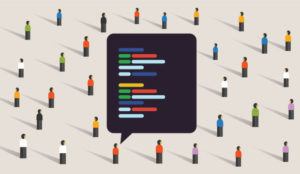Remember the Y2K bug? You know, the one that cost billions of dollars (US$) to fix? Wasn’t it strange that the countries that did not prepare for technological disaster had exactly the same experience as the countries that did? Right — nothing happened.
Nevertheless, there are still a handful of hopefuls out there who are waiting for Y2K to strike. If nothing happens again after the “real millennium” takes place in 2001, they are planning to merge with the Flat Earth Society. The digital divide fanatics should join them.
Researchers have to make a living, so they can hardly be blamed for stretching to come up with study topics. But sometimes it boggles the mind that so many otherwise intelligent people greet their most obvious conclusions as alarming revelations. Poor people are less likely to own computers than rich people! Young people are more likely to use the Internet than old people! Come on, gang — let’s form a commission to study this some more!
‘Racial Ravine’
In July of 1999, the U.S. Commerce Department released its report, “Falling through the Net: Defining the Digital Divide,” which found that households with annual incomes of $75,000 or more were twenty times more likely to have Internet access and nine times more likely to have computers than families in the lowest income bracket.
The report did not comment on whether upper income families might also be more likely to have sport utility vehicles, diamond jewelry and purebred Dalmatians for pets. The finding that grabbed the most headlines was that whites were more likely to have Internet access at home than African-Americans or Hispanics were to have Internet access anywhere — home, school or work.
“America’s digital divide is fast becoming a ‘racial ravine,'” Assistant Secretary of Commerce for Telecommunications Larry Irving said. “It is now one of America’s leading economic and civil rights issues and we have to take concrete steps to redress the gap between the information haves and have-nots.”
‘Alarming Disparity’
At about the same time, a report from Greenfield Online indicated that more than half of American college students would have Internet access in their residences and 84 percent would have access elsewhere on campus by the fall of 1999. The report commented on the relationship between Internet access and online shopping, disclosing the amazing news that a lot of college students were buying CDs on the Web, even though most of them did not have much money. I wonder how much it cost the firm to figure that out.
The college study seemed to shift the focus from race to age as the most important determining factor for the technology gap. Research on the United Kingdom’s digital divide from consulting firm Booz Allen & Hamilton corroborated that notion. The consulting firm said — better sit down for this shocker — that nearly half of the country’s Web surfers were 15 to 24 years old, while only one in 25 people over age 64 used the Internet. The report called it an “alarming disparity.”
But what I’m really wondering is if anyone has done a study comparing how many 15 to 24 year olds vs. people over 64 own Sony Discmans, ride skateboards, or know how to foxtrot.
Racial Blur
In April of 2000, Forrester Research issued a study on the digital divide that negated the most controversial conclusion of the Department of Commerce findings. Forrester said that income — not ethnic background — is the determining factor for Internet penetration, followed by age, education and “technology optimism.”
Forrester reported that Caucasians ranked third behind Asian-Americans and Hispanic-Americans in online access. “It’s really about income and whether someone has the opportunity,” analyst Ekaterina O. Walsh said.
Walk This Way
Forrester’s study should have infused the discussion with a heavy dose of common sense, but now that the digital divide has caught the imagination of politicians, many of them are waving the technology flag, calling for efforts to close the gap in third world countries.
A panel of information technology experts commissioned by United Nations Secretary-General Kofi Annan reported earlier this year that urgent action was needed to slow the digital divide separating rich and poor nations.
The panel said the United Nations should set a goal of allowing everyone in the world access to a computer and the Internet by 2005, even if they have to walk half a day to hook up with a mobile phone. If nothing is done, poorer nations could be permanently excluded from the Internet revolution, the experts warned.
Converting the Masses
Just what is the supposed fallout from the digital divide “crisis?” The Internet is a wonderful vehicle for information and communication, and I am all for wiring every school and every public library for access. I support programs that help people develop high-tech job skills — especially if they are targeted toward groups with special needs, such as one I recently heard about at a youth correctional center.
But I don’t think people will suffer or the world will be plunged into a state of crisis unless everyone gets the Internet at home. The fact is, most people now use computers and the Internet for entertainment and convenience.
Kids play video games. Teenagers chat with friends via instant messaging programs, college students go online to download music, and older adults take advantage of movie listings, efficient shopping, and online banking. That’s all great, but the people who lack these advantages are not facing an imperiled future.
First of all, many of the Internet “have-nots” are really “want-nots.” Not everyone wishes to be converted to the Religion of Technology. I know some well-heeled individuals who actually don’t have answering machines — or even call waiting. News flash: Some people choose not to own TVs! Some people still read newspapers — and some of them do it for free in comfortable chairs in public libraries.
A PC in Every Pot
It is ridiculous to characterize the Internet as a necessity for survival in the modern age. Computers and Web appliances are now relatively cheap, and free Internet access is available in many areas. Even lower income families could find a way to get wired if they viewed it as a high enough priority. Those who cannot have bigger problems than not being able to get online.
As long as the so-called digital divide sucks money and attention from the world’s real problems, it is a dangerous myth. The idea that people in third world countries should be encouraged to walk a half-day to have an Internet experience is obscene.
The digital divide is not a crisis. World hunger, wars, AIDS, and environmental decay are crises. When the Internet can solve those problems, maybe everyone needs to have a computer. In the meantime, technology is moving fast enough.











































Thank you. You covered it perfectly. Some may get upset, but you nailed it. People with out computers? What no library? Some schools will even let you use their systems. Many who are not connected don’t want to or choose not to. Do you choose a $100 pair of shoes or a $200 outfit. You can buy a nice entery level PC with internet service for 2 pairs of shoes and an outfit. The other part is, what are the majority of people doing on the Internet? Who registers the most hits everyday? Probably not Foxnews, CNN, or ECommerceTimes unless they have gotten into porn or pirated music.